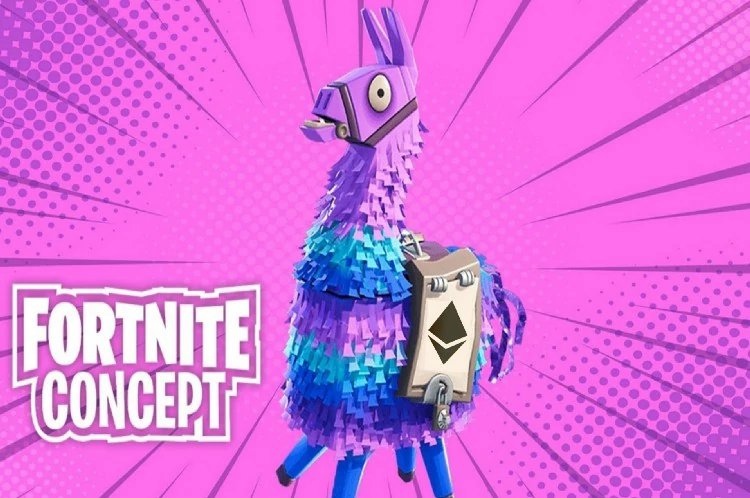Fortnite Overview
Fortnite, the latest creation of Epic Games, is a free-to-play online multiplayer “Battle Royale” video game which has sprung into massive popularity in recent years. For those who are unfamiliar with battle royale, the mode drops 100 random players on an ever-shrinking map scattered with weapons, resources, and other useful items that can be used to defeat opponents. The match ends with only one player or team standing.
In September 2018, Epic Games reported over 78 million monthly active users. In comparison, Minecraft reported 74 million monthly active users in December while League of Legends still holds the crown with over 100 million monthly active players. With this in mind, we want to note that Fortnite has yet to be released in China, which is one of the largest markets for online gaming.
Regardless, Fortnite has become massively popular within the gaming community and has allowed Epic Games to generate hundreds of millions of dollars each month through their unique revenue model. With the growing potential for blockchain-based gaming, we at Fitzner Blockchain Consulting want to take a moment to speculate and explore what a “tokenized Fortnite” might look like.
Overview of the Fortnite Ecosystem
Epic Games sells an in-game virtual currency called V-bucks that allow players to purchase seasonal battle passes and unique cosmetics. These battle passes, which expire each 8–14 week season, unlock additional content, in-game cosmetics, and a long list of challenges for players to complete in order to level up. While Fortnite is inherently a free-to-play game, battle passes give players significantly more content and cosmetics to unlock through a leveling based system.
Epic Games leverages their “seasonal” gameplay by recreating different areas of the map supplemented by cosmetic branding to match the new theme. As a result, players who wish to stay up to date with that latest cosmetics must purchase (950 V-bucks or $9.50), and complete new battle pass challenges every season.
These cosmetic items are priced in terms of quality and level of detail of the respective cosmetic item. For example, a rare “green” skin offers a minor change in character’s appearance and adds a slight uniqueness to your character’s look while a legendary “gold” cosmetic largely changes the character’s’ appearance and has a more precise attention to detail. It is important to note that despite the various prices, these skins and cosmetics offer zero competitive advantage and are solely for appearance. This approach allows Fortnite to avoid a controversial “pay-to-win” model.
Moreover, unique cosmetics and other items can only be purchased with V-bucks through the in-game shop. The store only offers a select few items per day with new items rotating every 24-hours. As a result, skins and other cosmetics generally gain a degree of scarcity as these items are often only available for a period of 24 hours. Players have no option to vote or select which items will be sold in the shop as these decisions are made by the parent company, Epic Games. More importantly, all cosmetics are non-tradeable and offer zero liquidity to users who own them outside of their specific Epic Games account.
V-Bucks as a Cryptocurrency
A tokenized gaming economy can unlock a multitude of benefits and unique features for players. First and foremost, tokenized V-bucks would enable peer-to-peer transferability. This would allow users to send and receive tokens between friends, professional content creators, and other players. Potentially users may be more inclined to purchase larger amounts of V-bucks as there are no longer any sunk costs due to liquidity post-purchase.
Depending on the underlying model, different token economies would present unique benefits and drawbacks. Given the fact that a large majority of Fortnite players are under the age of 18, we have decided that Epic Games releasing a utility token would be highly problematic due to the inherent volatility in digital assets. As a result, with the rise of JPM coin and newly announced, Facebook Coin, we are beginning to see that stablecoins may be the preferred cryptocurrency adopted by traditional companies due to low volatility and stable value.
V-Bucks as a Stablecoin
In recent months, stablecoins have gained a large amount of traction from blockchain enthusiasts and respected firms such as JP Morgan Chase, Telegram, and Facebook. If you do not have a solid understanding of stablecoins, feel free to refer to our article which outlines the topic in detail.
For Epic Games and the Fortnite ecosystem, V-bucks as a fiat-collateralized stablecoin would likely make the most sense for long-term stability. This digital asset would be backed 1:1 by legal tender with every V-buck having a single U.S. dollar locked as collateral and held in custody to be redeemed at any time. With a stablecoin, volatility in the underlying asset is removed while the benefits of a blockchain-based currency flourish. To reiterate on our points above, V-bucks as stablecoins would provide a secure system for peer-to-peer transfers, transparent accounting, and fractional liquidity.
Theoretically, stable pricing would allow secondary markets to become more efficient. This would provide additional sources of liquidity outside of Epic Games and the potential for new trading pairs to create direct transfers between other in-game currencies on platforms such as Blizzard (Overwatch), Activision (Call of Duty), Bungie (Destiny/Halo) and/or EA (Anthem/FIFA).
The question now becomes: If every dollar is required to be locked in collateral, how would Epic Games profit off the sale of V-bucks?
Simply put, in the same way that they sell digital assets and content now.
Although if there happen to be additional fees that cannot be included within these content prices, the easiest solution would be to implement a small transaction fee on every purchase of V-bucks. Depending on the underlying platform being used to create the stablecoin, fees could be incurred in the form a cryptocurrency such as Ether (a barrier to entry in our mind) or ideally, as V-bucks themselves through the creation of a permissioned blockchain by Epic Games. These fees would have to be minimal enough to not disrupt the current system but theoretically would create an additional revenue stream beyond the sale of V-bucks themselves.
Another, less accepted, mechanism would be for Epic Games to leverage a degree of fractional banking. For those unfamiliar with fractional banking, it requires banks to hold a fraction of the money deposited as reserves with the rest of the money allowed to be lent out to other individuals or businesses and, is the basis of our modern financial system. This would allow Epic to continually mint and sell new V-bucks beyond the amount of collateral in their internal reserves. Even though this is how our current monetary system works, the largest issue surrounding this approach is the ability for Epic Games to retain the 1:1 peg in the event of an overwhelming amount of sell pressure (buy pressure could always be countered by simply minting new V-bucks).
Cosmetics & In-game Events as NFTs/divisible NFTs
With skins and other cosmetics acting as the backbone behind the Fortnite economy, it would largely make sense to leverage the potential of ERC721 and EIP864 which describe non-fungible tokens (NFTs) and divisible NFTs, respectively. With the ability to represent skins and other cosmetics as non-fungible tokens, Epic Games would be able to release digitally scarce skins to users in store. As a result, players would be able to purchase cosmetics in-store and profit off any significant increase in demand for the item or other unique skins.
In the current model, Epic Games decides when and what skins are released in the store. With non-fungible tokens, the company can maintain a very similar model with a unique spin. In theory, skin creators could mint a specific amount of the underlying asset, let’s say 1,000 skins, but only release half of them on the store for a set amount of V-bucks each. The creator, in this case Epic Games, could then retain the other 500 skins in a “vault” to be released periodically over time in-store and at the respective market price. This would allow Epic Games and other verified creators to profit off the popular skins months, or even years, after they’ve been released.
Furthermore, early adopters could benefit from purchasing limited-time skins that may are no longer be available as the game moves into later seasons. Similarly, players who completed early season battle passes would have seen a significant increase in demand for their cosmetics as the game began to gain more traction.
With all this in mind, skins and cosmetics might be the tip of the non-fungible iceberg. This past February, Epic Games brought the first ever live concert on Fortnite with a performance by Marshmello, a popular EDM artist. The event brought millions of attendees together to listen to a concert in the middle of Pleasant Park. While this first event was inherently free, we can definitely foresee similar events utilizing a paid model. In the world of blockchain-based gaming, the admission into these playlists could easily be monitored and validated by scanning a player’s wallet to check that an NFT-based ticket was purchased.
Competitive Play
Competitive gaming and Esports has seen a surge in popularity over the past decade. Games such as League of Legends and Dota 2 have drawn massive audiences with lucrative prize pools for professional teams. The League of Legends World Championship drew in over 200 million concurrent viewers in 2018. Dota 2’s International tournament in 2018 had a prize pool of $25.5M with $11.2M going to the first-place team. The most interesting aspect of the International tournament is that the prize pool is largely community driven with individual players contributing cash directly into the pool.
Epic Games recently joined in on the esports hype by putting up $100 million in cash prizes for the Fortnite World Cup this July. The world cup will feature the world’s top 200 players competing against each other for a $3M championship prize and $50,000 for any player who qualifies.
It’s obvious that there’s a growing economic incentive for the highest possible talent to compete against each other in video games. Unfortunately, there still remains a large pool of talented players who are unable to cash in on their skills, to any degree.
To this end, tokenized V-bucks would enable a trustless mechanism and globally accessible ecosystem for users to “stake” V-bucks in order to enter competitive play.
For every competitive match that a player joins they would be required to contribute a small portion of their stake to the winner’s pool. Moreover, for every elimination or kill, the player can earn some portion of the other player’s stake. For every death, each player loses a small portion of their stake.
In essence, users who maintained a K/D ratio above 1.00 would essentially become “profitable players” who continuously earn additional revenue for entering competitive play. Players who can frequently place within the top percentile of the match, let’s say top 10, could earn additional prize money on top of the V-bucks they earned from eliminating players throughout the match. Ultimately, users who have a profitable run in competitive play could cash out their earnings by incurring a small fee to the custodian, in this case Epic Games, and put US dollars (or Bitcoin/Ether) into their bank account from playing Fortnite.
Fortnite Governance
It’s increasingly evident that Fortnite’s community is far more engaged than any game we’ve seen to date. Whether it’s discussions surrounding new guns, how to complete a battle pass challenge or the reception of a new game mode, Fortnite is a perfect example in which governance clearly matters.
One of the largest prospects surrounding blockchain is the ability for digitized voting. Specifically, as it relates to Fortnite, V-bucks could provide users with the ability to vote on governance issues. This concept could provide users the ability to either vote directly with V-bucks themselves (think 1 V-Buck equals 1 vote) or by using their respective weighted balance relative to the total supply as a proxy to how influential their vote(s) should be.
Without getting too deep into the political nature surrounding these different voting systems, it goes without saying that dedicated players (i.e. professional players, content creators, and/or developers) could directly influence how Fortnite evolves over time. Rather than waiting for changes to take place over the course of multiple updates, an ongoing governance team would be directly responsible for overseeing and monitoring feedback on all new updates. While updates could apply to the game as a whole, it would be more practical for governance polls to be segmented towards different audiences such as competitive game modes, map updates, or weapon spawn rate/damage calculations.
Taking this a step further, the argument could be made that a governance-based token should be separate from the currency used to purchase cosmetics. The majority of players participating in governance will likely have different motivations than the average recreational player.
Regardless, we think the large majority of Fortnite players would agree that an enhanced voting system would definitely be preferred. Although it may take a bit of legwork on Epic’s side, increased purchase of V-Bucks to participate in governance would make their troubles worthwhile.
Conclusion
The potential implementation of different tokenized models in Fortnite is endless. While we’ve only scratched the surface, it’s fascinating to consider how these ideas might shape the way video games leverage new business models moving forward. If Fortnite has taught us anything, it’s that you don’t have to charge $60 for your game to be profitable.
Gaming is an industry that blockchain-based projects are largely trying to capture, and we hope that our ideas can add value to the dozens of new gaming-based ecosystems being built each month.
Until then, be sure to stay tuned for content, and we’ll see our fellow Fortnite enthusiasts on the battle bus!
Interested in Block Chain Game, Welcome to JBB.ONE









